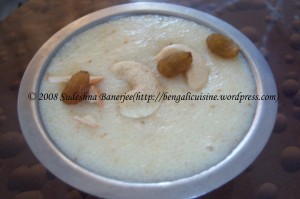We’ve moved to own domain name – bengalicuisine.net. You can follow me on Twitter, visit my Flickr photostream.
Durga Puja is a big occasion for all Bengalis and for that matter anybody who has a Bengali friend or acquaintance. Everyone who is a Bengali by heart looks out for those few days of the year when the mother goddess comes down to earth and showers her blessing. Durga Puja is also a great occasion to me too, but especially I like the Sandhi Puja night. There is of course a reason behind this liking. It is the night when the goddess is offered Sujir halwa and luchi. It just tastes so good in that combination and my mom cooks it just the way I love; not to flaccid not too condensed, just the right consistency to have it.
Not only during Durga Puja, Sujir halwa always has a soft corner in all our hearts, so throughout the year, mom prepares it often. Mom is not there now with me here in my Bangalore flat, so when it comes to having something typically Bengali I have to enter the kitchen. The other day I prepared Sujir halwa, though I couldn’t get the feeling of my mom’s love in it, but yes it satisfied my taste buds.
Serves 4
Ingredients:
Semolina (Suji / Rava): 4 heaped tablespoons
Clarified Butter (Ghee): ½ teaspoon
Milk (Dudh): 2cups (300ml)
Sugar (Chini): 2 tablespoons
Cardamon (Elaichi): Seeds of 2 or 3 crushed to form powder
Dry fruits for garnishing
Preparation:
- In a wok heat the ghee in simmering flame
- Add the semolina along with 2 bay leaves to it and toss for a minute or two
- Pour in the milk along with sugar and let it boil, stir every two to three minutes to ensure that the semolina doesn’t get stick to the bottom of the wok
- When half cooked add the cardamom powder to it and stir well so that it gets mixed to the halwa
- As the semolina thickens take it out of flame and serve with dry fruit garnishing
Sujir payes serves as a good accompaniment with luchi or even can be had hot or cold as a dessert. Depending on how you like it, you can also add more or less milk to make the consistency of your choice. I like it uncondensed and so I have added more milk to it.
NB: Be very careful when you are frying the semolina in ghee, because with heat just above the optimum heat, semolina tends to get burnt. It is better to fry it in low flame with constant stirring, and ensuring that the milk is within your reach.
Check for my fiftieth post here on this blog, till then Happy Cooking, Happy Eating
You can also Subscribe to BengaliCuisine by Email, or Subscribe in a reader

























